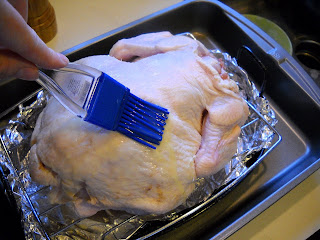
Last summer some of my fondest memories are of making grilled pizzas with my father. In the two months before my wedding there were many things to busy ourselves with, but this was a time for us to kick back and enjoy cooking some amazing food. My dad would fire up the grill while I finished grating mozzarella and double checking the seasoning of the tomato sauce. While toting all of the pizza ingredients outside, I would grab two bottles of beer, usually seasonal ones from an Oregon brewery.

To get started, my dad would hold one rolled pizza dough and I would brush olive oil on the top side. Then he would carefully lay it oiled side down on the hot grate and close the lid. As the first two pizzas began to brown, we would sit back and start sipping our beers. Two umbrellas on the deck provided enough shade to ensure a comfortable temperature. After a few minutes one of us would hop up and peek under one of the pizzas to make sure they weren't cooking too fast (we learned this the hard way the first time!). As my dad brushed oil on the uncooked side of dough, I would grab the bowl of tomato sauce and a large spoon. The pizzas would get flipped and I would quickly spoon on the sauce and grab a handful of grated mozzarella to sprinkle on top. Then we would resume our seats with our bottles of cold beer and continue our conversation.

A few minutes after applying the sauce and mozzarella, the cheese had melted and adhered the toppings to the dough. A quick sprinkle of freshly chopped basil, and we were done! My dad would grab the tongs and carefully slide the pizzas onto the plates I was holding. Every time we made these, we would marvel at how well they compared to the rustic pizzas we had enjoyed in Italy. Even though it's been 18 years since my family's trip there, I will never forget those simple pizzas, bursting with flavor from the bright red tomatoes, fresh picked basil and creamy mozzarella.
I have always been a "Daddy's girl" and it was times like these that taught me how truly special it is to have parents who are incredibly loving and supportive. My dad was one of my best friends and I know he is smiling down on me from a better place. When I make these grilled pizzas I am reminded of those warm summer evenings where I enjoyed hanging out with my dad and creating a truly delicious meal.

Quick Grilled Pizza
Makes four 9-inch pizzas
Sauce:
2 (14.5 oz) cans diced tomatoes, drained well
2 tablespoons chopped fresh basil
2 tablespoons extra-virgin olive oil
2 garlic cloves, minced
1/4 teaspoon salt
*I you'd like to use fresh tomatoes (which I did), toss 1 1/2 pounds cored, seeded, and chopped fresh tomatoes with 1/2 teaspoon salt in large bowl. Transfer to a paper towel-lined plate and let drain for 15 minutes. Make sauce as directed.


Pizza:
1 cup water, heated to 110 degrees (Hot tap water works)
1 tablespoon extra-virgin olive oil, plus additional for brushing dough
1 tablespoon sugar
1 envelope (2 1/4 teaspoons) rapid-rise or instant yeast
2 3/4 cups all-purpose flour, plus additional as needed
1/4 cup grated Parmesan cheese
1 teaspoon salt
2 1/2 cups shredded mozzarella cheese
1. Make Sauce:
Combine tomatoes, basil, oil, garlic, and salt in medium bowl; set aside.

2. Prepare Dough:
*Note: This can be done in a bread maker if you prefer.
Whisk water, 1 tablespoon oil, sugar, and yeast in large liquid measuring cup. Let sit 5 minutes.

Pulse flour, Parmesan, and salt in food processor until combined.

With machine running, slowly pour in water mixture and process until dough pulls away from sides and forms shaggy ball, about 1 minute. (If dough seems too sticky, add up to 2 tablespoons more flour.)

Turn dough onto floured work surface and knead 3 or 4 times until cohesive.

3. Shape Pizza:
Line baking sheet with parchment paper and dust with flour. Divide dough into 4 equal pieces. Working with 1 piece at a time, press into small circle. Using rolling pin, roll and stretch dough to form 9-inch circle. Transfer to prepared baking sheet and dust dough with flour. Repeat with remaining dough, stacking each round on floured parchment sheets.

4. Heat Grill:
Meanwhile, heat all burners on High, covered, for 15 minutes. Leave primary burner on high and turn other burner(s) to Med-Low. (For charcoal grill, light about 100 coals; when they are covered with fine gray ash, spread over half of grill. Set cooking grate in place and heat, covered, with lid vent opened completely, for 5 minutes.) Scrape and oil cooking grate.
5. Grill Pizza:
Brush tops of 2 dough rounds lightly with oil. Peel rounds off parchment and place, oiled side down, on cool side of grill. (*Don't move for the first minute, or it will tear.) Grill, covered, until undersides are spotty brown and tops are covered with bubbles, poking large ones with tongs, 3 to 5 minutes.

Brush each lightly with oil and flip. Top each round with one-quarter sauce and one-quarter mozzarella. Grill, covered, until undersides are spotty brown and cheese is melted, 3 to 5 minutes. Move pizzas to hot side of grill to crisp, about 1 minute. Repeat with remaining rounds. Serve.

(*Note: Keep first batch warm on a wire rack on a baking sheet in a 200-degree oven.)









































